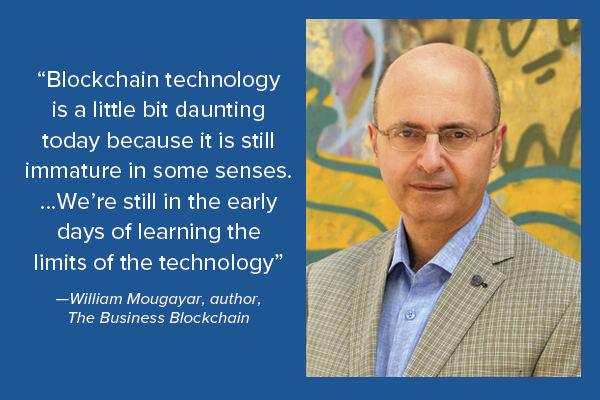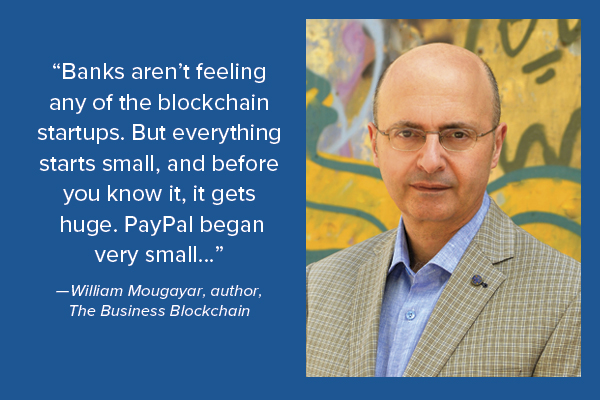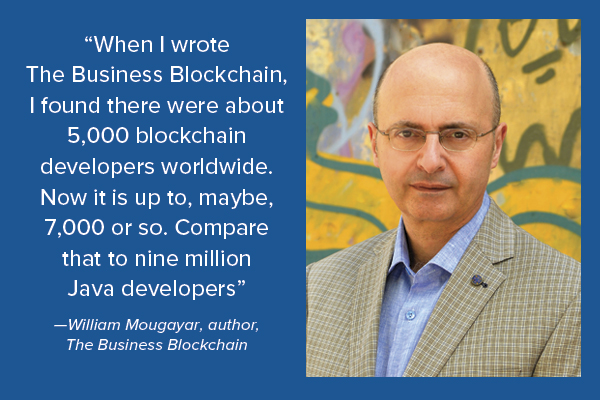Blockchain will revise banking reality
Talking with author and investor William Mougayar. He says fledgling technology could reboot financial services
- |
- Written by Steve Cocheo
 "Blockchain is a new set of rails," says William Mougayar, author of The Business Blockchain. "And it is going to be a more efficient set of rails than the multitude of proprietary solutions and spaghetti kind of integrations that we have today. We now have a chance to rethink all of this."
"Blockchain is a new set of rails," says William Mougayar, author of The Business Blockchain. "And it is going to be a more efficient set of rails than the multitude of proprietary solutions and spaghetti kind of integrations that we have today. We now have a chance to rethink all of this."
Centralization makes many people, but especially bankers, comfortable, secure, and able to sleep at night. As much as bankers may beef about regulators and “inside the Beltway” thinking, the idea of federal regulation and supervision provides a magnetic north. The Federal Reserve itself is a “central bank,” and it and key private players, like The Clearing House, Visa, MasterCard, and NACHA, serve as key central points for the movement of what we consider to be real “money,” even though today it mostly consists of blips in databases.
But blockchain technology and cryptocurrencies—founded on the concept of the distributed ledger, the opposite of a central database—are, to use the vernacular, messing with the centralized concepts about financial services that bankers grew up with.
Steem is an example—one of author and venture capitalist William Mougayar’s current, blockchain-based favorites. The Steem website defines itself as “a blockchain database that supports community building and social interaction with cyrptocurrency rewards.”
“If you publish some content on Steem and somebody ‘up-votes’ it, then it earns you some money,” says Mougayar. Within the Steem community, there are ways to spend that money.
“I call this approach a circular economy, where you can earn and spend money without leaving the marketplace,” Mougayar continues. “It looks like ‘funny money’ to outsiders. They’ll say, ‘How can you print money?’ But it’s the same as greenbacks. You earn it, get a paycheck, go spend it. It’s like going into a new country with a new currency.”
What relates most to banking about Steem is the trust aspect of its blockchain, an illustration of a key element of this technology.
“Blockchain solves the ‘double-spend’ problem,” Mougayar explains. “We can send value back and forth digitally without fearing that it’s been used twice. If I send you value, I don’t have it anymore, in a blockchain, and the blockchain can be used to track all of this value because its records are immutable.”
Not that the payments system that we live with was planned to be the way it is.
“Business-to-business payments are full of inefficiencies,” points out Mougayar. He sees blockchain technology disrupting this sphere sooner than consumer payments. “Blockchain is a new set of rails,” he says. “And it is going to be a more efficient set of rails than the multitude of proprietary solutions and spaghetti kind of integrations that we have today. We now have a chance to rethink all of this.”
Mougayar has been on a personal voyage of discovery about blockchain technology. His quest became The Business Blockchain: Promise, Practice, and Application of the Next Internet Technology, published in 2016. [Reviewed by Banking Exchange in "Your guide to the blockchain revolution"]
Next year, Mougayar will continue his thinking in the book Centerless: Rethinking Trust, Wealth, and Information in the Age of Decentralization.
Mougayar’s earliest take on blockchain was that it was just a new wrinkle in the internet or a new feature of the web. At the time, people still thought chiefly in terms of Bitcoin as well as other cryptocurrencies when discussing blockchain. Further study, however, changed Mougayar’s mind.
“I saw that it would be very similar in impact to the web, which was transformational,” says Mougayar.
Not that everything in the blockchain world has gone smoothly. Bitcoin has had its difficulties. Mougayar likes to quote Andreas Antonopoulos, a tech writer and entrepreneur, that Bitcoin “has died 120 times already and yet it’s still there.” But Mougayar is convinced that ubiquitous adoption of blockchain technology in financial services has become a “when,” not an “if.”
The following summary of a far-ranging interview with Mougayar—whose new blog "Business of Blockchains" has joined the Banking Exchange lineup—has been edited for length and clarity.
Q1. You made a point in a blog that the blockchain is “80% business and 20% technology.” Do you think blockchain will alter the mechanisms of business or the very nature of business today?
Mougayar: Actually, I have updated that statement, inspired by Yogi Berra. Now, I’m saying the blockchain is 90% business and 50% technology.
Yes, it doesn’t add up to 100%. If it did, it would end up being like any old IT project. You can think of improving current processes as many big companies do. But if you do that—not changing anything and just using blockchain to support existing processes—you are just using a fraction of its potential benefits. Blockchain can be used, like the web, to reengineer and rethink processes. That’s why I say it’s 90% business. You have to figure out what is going to change in your business. The blockchain is here to force us to rethink existing business models.
Blockchain technology is a little bit daunting today because it is still immature in some senses. We are still not too sure what’s going to scale and what’s not. We’re still in the early days of learning the limits of the technology.

Right now, most of the innovation I’ve seen is taking place outside of large companies. That’s because large companies traditionally are challenged in creating new business models.
Big companies aren’t very good at acquiring new customers. They are good at keeping customers. On the other hand, take Clearmatics, for example, out of the United Kingdom. The firm is a start-up that is creating a new, decentralized clearing network for over-the-counter derivatives. It will start out with zero customers.
Some large companies do what I call “hand waving as a strategy.” They feel they have to indicate they are doing something in a space, and, depending on who you are, you can hold your audience captive for a while. Not picking on IBM in particular, but IBM is notorious for making announcements ahead of product deliveries. Customers will wait a year for IBM because it’s IBM.
Start-ups will push the envelope, and some will not succeed. But that’s the nature of the field. Without ambitious start-ups, we’ll never know where the boundaries are.
At present, banks aren’t feeling any of the blockchain start-ups. But everything starts small, and before you know it, it gets huge. PayPal began very small and is now a multibillion-dollar company that has expanded into lending. Banks may end up becoming back shops, no longer the front ends.
Q2. Do you think that the banking industry has been going about blockchain research and development in the right way?
Mougayar: I think banks ought to be taking a portfolio approach to blockchain projects—not counting on one thing. Nearly all of the big banks are involved in the R3 CEV consortium, for example, and in bilateral or trilateral projects, or mini-groups.
My message is: “That’s not enough.” In a consortium, everyone is moving on the same level and in the same direction. No one is going to one up the other when they are all playing the same game. Collaboration is a good way to test concepts. But you’re not going to get much competitive advantage out of collaboration. And banks do not like to share everything, so they will share the minimum.
So in their portfolio, banks must leave some room for new and innovative projects that will give them a competitive edge. That is where creativity and real innovation come into play. I see some large companies now talking to start-ups, trying to find ideas that could move their needle. [Editor’s note: Subsequent to the interview, several large banks left R3 CEV, reportedly in part out of concern for too little competitive help for their involvement.]

Q3. What about the smaller banks? Should they be looking at blockchain now, too?
Mougayar: They will have to wait a bit longer. They don’t have big budgets to invest. There is no payback yet. Big banks can afford to invest in blockchain, but smaller banks and credit unions need to utilize technology that is tried and true. We are not yet at the stage where they can buy an out-of-the-box blockchain solution for business-to-business payments, securities trading, or anything else they offer. But I think we will start to see those, perhaps, two years from now.
There’s an exception: an executive at a small bank who sees the blockchain as a really important technology. That executive will say, “I’m going to bet a small part of my company on that.” That bank will need to think and act like a start-up, get aggressive, and be willing to take risks. This takes unconventional thinking.
Q4. That brings us to regulation. Much of the rest of the world seems to have a friendly regulatory attitude toward innovation and blockchain development. I’m not quite getting that feeling from U.S. regulators.
Mougayar: The United States is more complex. You can’t totally compare the United States to Singapore, for example. Singapore is a very centralized government without a lot of moving parts. So if the government wants to do something, it can make that happen fairly efficiently. And there’s a lot at stake in U.S. financial markets and many regulatory agencies. It takes a bit more to wrap your head around it.
A wait-and-see attitude is not bad. Not taking regulatory action is good. It means regulators are letting blockchain technology evolve and mature, seeing what shape it will take. The worst thing you can do is regulate something too early.
My message to the regulators is that technology is all about innovation and that they have to innovate, too. I suspect that many of them will do so.
Q5. In late October, Comptroller of the Currency Thomas Curry made it pretty clear that he did not favor the concept of “sandboxes”—permitting innovation to proceed in a contained, protected environment. What are your thoughts on this?
Mougayar: I think sandboxes would be a way to test the implications of new technology without doing any damage to the rest of the system. If somebody says they don’t want to do sandboxes, that’s not a very progressive statement, in my book. That means they don’t want to push the envelope outside of the boundaries they know.
When the blockchain and cryptocurrencies are fully deployed, they will change the existing central authorities that we have. I think regulators must come to grips with this. Bitcoin has a market cap of $11 billion, which is not a big number, comparatively speaking. But significantly, it stands on its own 6,000 nodes of computers. Choke one or 100, and thousands keep on humming. No one body governs it.
The central authorities used to controlling everything will have to learn to coexist with such new forces. However, there’s an innovation that the blockchain enables that could benefit regulators. They can be a node on a blockchain network. That can give them the same seat as any other player, the same insights into transactions—all in real time. That would be a big change from the traditional pattern of demanding reports long after the fact.
Q6. “Smart contracts,” or self-executing business arrangements built on the blockchain, seem to be gathering momentum. How soon do you think true blockchain-based smart contracts will debut worldwide?
Mougayar: I’m disappointed that we haven’t seen some very simple use cases around smart contracts that touch consumers. A lot of the work done has been a bit too ambitious—centered on solving big problems with big companies, with smart contracts that are very complicated and part of bigger applications.
I’d love to see someone launch a very simple smart contract. How about a wager application? If you and I want to bet on the World Series or tomorrow’s weather, we could bet via smart contract. The smart contract would check the scores or check the weather, and automatically pay you a Bitcoin or pay me one.
At the end of the day, smart contracts are just logic—business logic encoded in software—allowing money to be exchanged if certain conditions are met or not met.
Q7. You are both a student of this technology and an investor. What is a yardstick for projects with potential versus those that don’t look like they will get legs?
Mougayar: There’s a wide range of composition and “flavors” among start-ups. One factor that’s different today is that start-ups don’t necessarily need to go to venture capital to raise money. A credible start-up could raise its own money by spinning off its own currency. That is a very unique and innovative method for the cryptocurrency environment.
Ethereum, a Bitcoin competitor, started that way with an $18 million ICO (Initial Cryptocurrency Offering) as opposed to an IPO. Before you knew it, an ecosystem had been created.
There are over 300 start-ups built on Ethereum and more than 100 big companies developing projects and proofs of concept on it. Its valuation is over $1 billion, and there are thousands of developers.
It’s not just Ethereum. There are dozens of others at this point, tying their business model to a token of some sort that has value.
Yes, there will be speculation. And that’s okay, if it is short-lived, because speculation funds innovation.
Money that’s generated by prices that rise end up benefitting the entrepreneur and benefitting the investors. Some start-ups are using these windfalls from cryptocurrency appreciation to fund their operations.
One thing required is human capital. I’d like to see more developers who are knowledgeable about blockchain technologies. When I wrote The Business Blockchain, I found there were about 5,000 blockchain developers worldwide. Now, it is up to, maybe, 7,000 or so.
Compare that to nine million Java developers. I cite Java because it proved instrumental for the web. Java allowed developers to write an application once, and it could run anywhere on the web. The web took off.

So we need more blockchain developers, and for that, we need courses teaching blockchain, cryptocurrencies, consensus models [which help blockchain communities work], game theory—all computer science stuff and software engineering.
If we don’t do it here in North America, I know China is very serious about blockchain. China will take all of the research we’ve done, and it could, maybe, apply it better.
Consider this: The top three languages that my book has been translated into are Chinese, Japanese, and Korean.
Disclosure: William Mougayar is an advisor to Steem, and holds Steem, Bitcoin, and Ethereum cryptocurrencies.He is based in Toronto, Canada.
Read Banking Exchange review of The Business Blockchain
Visit Mougayar's new Banking Exchange blog, "Business Of Blockchains"
Visit the Banking Exchange Blockchain Channel
Tagged under Technology, Blockchain, Feature, Feature3,













